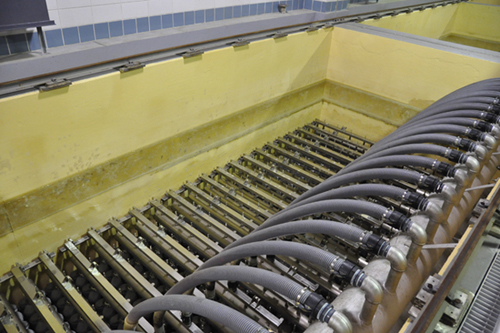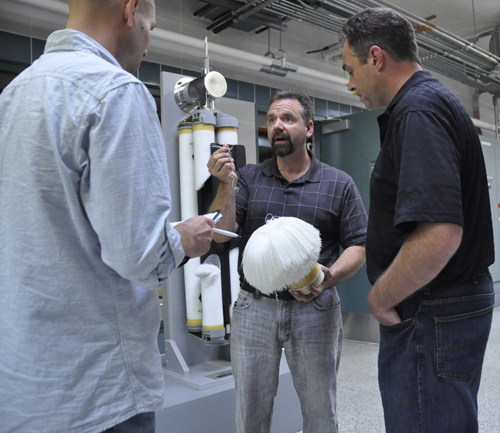Membrane Trust: A Solution To Capacity And Contaminants

By Kevin Westerling,
@KevinOnWater

By converting from sand filtration to membrane filtration, Forest Park Water (FPW) improved its water quality, increased capacity, and removed operational issues inherent to multimedia filters. Learn how the utility went from conventional to “advanced” while keeping its footprint and its finances in check.
Forest Park Water (FPW), built in 1994, has always been somewhat ahead of its time. Even today, the nearly 20-year-old suburban Philadelphia water treatment plant (WTP) looks modern. More impressive, however, is what lies within — both in terms of people and technology. The management team has long-term vision, which led them to make a major upgrade in 2007 that improved water quality and doubled capacity, a move necessary due an explosion in population and business growth. Regulations have grown over time as well, in both number and severity. With regulatory issues such as the Stage 2 Disinfectants and Disinfection Byproduct Rule (D/DBPR) and the 4-log removal of microorganisms lurking on the horizon, it was clearly time (at least for the proactive group at FPW) to upgrade its conventional sand filtration treatment process.
The replacement technology to adopt was also a clear decision, according to Wayne Letourneau, FPW’s operations director. Letourneau asserts that, for him, membranes were at the time — and still are — the future of water treatment, based on empirical research and performance. After four years of vetting and testing prior to installation, FPW selected membranes (Siemens Memcor) with a pore size of 0.1 microns, which is right at the juncture of microfiltration (MF) and ultrafiltration (UF) — UF membranes having a pore size of 0.01 to 0.1 microns, while MF goes from 0.1 to 3.0 microns. About 45 million hollow-tube fibers, contained within more than 4,000 modules, are incorporated in what is one of the largest membrane WTPs in the eastern U.S., according to the consulting engineers on the project, Gannett Fleming. The racks essentially overtook the basins used for the old media filtration, meaning there was no change in footprint. With regard to impact, however, the change was dramatic.

A submerged rack of membrane filtration modules
Planning For Prosperity
Most noteworthy, FWP increased its capacity from 20 MGD to 42 MGD, which will sustain the community’s water needs for decades to come. Currently, the plant only operates at 16 to 25 MGD, serving approximately 50,000 accounts (~200,000 people) over two counties. FPW also serves two water districts — the North Wales Water Authority (NWWA) and the North Penn Water Authority (NPWA) — which is the result of a unique and highly successful partnership. The neighboring authorities, with shared values of sustainable and responsible water management, decided to join forces to also share a new (circa 1994) treatment plant, the associated capital expenses, and the water coming out of the facility. By taking advantage of economies of scale, specifically with the 2007 plant upgrade, both authorities — and the communities they represent — continue to prosper.
The upgrade to FPW cost $34 million but also included the installation of innovative telescoping vacuum sludge collectors and deep-tank floating wastewater plate settlers, an on-site hypochlorite generation system, automation and control systems, and dual-diesel standby generators for operational security. The membrane filtration portion of the upgrade was about $6 million.
A point of pride for NWWA and NPWA is that the capital costs were covered without the benefit of government grants or special loan programs; the authorities self-funded the upgrade with the purchase of a bond, as well as some savvy revenue creation. Part of the business expansion in the area includes a large pharmaceutical company, which was contracted to buy 5 MGD from FPW. A deal was also struck with a number of cell phone carriers to rent space on municipal water towers — saving building costs for those companies, while also saving money for the water authorities’ ratepayers. In fact, despite the capital costs incurred by the FPW upgrade, NWWA and NPWA both plan on keeping rates consistent for consumers over the next five years (currently $3.65 per 1,000 gallons at NWWA; $4.63 at NPWA).
Better Operations, Better Water
FPW has a staff of 20, with one operator at all times dedicated to oversight and maintenance of the water treatment process. The oversight aspect is facilitated by SCADA, which FPW’s Letourneau identified as an essential element to operations. SCADA monitoring, in concert with laser turbidimeters, will “red flag” abnormalities, most often attributable to broken membranes. Pressure decay testing with visual inspection is also necessary — when bubbles appear, there is likely a break. Repair, however, is relatively simple: the rack is lifted, the module is removed, and a simple pin is inserted into the damaged membrane.

Wayne Letourneau, FPW’s director of operations, talks to Water Online team members about membrane O&M.
Maintenance also requires regular backwashing of the membranes, every 45 to 50 minutes, to prevent fouling. The vigilance has paid off for FPW and Letourneau, who says the membranes “look like new,” even after nearly six years of use. While the typical life expectancy for MF membranes is 5 to 7 years, FPW’s membranes are prorated for 10 years.
With regard to performance, Letourneau and staff couldn’t be happier. Though the membranes are technically classified as MF (per vendor description), Letourneau says they perform like UF membranes. The new system provides a secure barrier against harmful pathogens such as cryptosporidium and giardia, total organic carbon (TOC), and a host of microscopic particles that sand filtration can’t catch. The enhanced water quality, pain-free O&M, and the increase in capacity (without an increase in footprint) are clearly benefits, but what about the drawbacks to membrane filtration? When posed the question, Letourneau answered plainly, “None that I can think of.”
Treatment alternatives that perform to the similar standards are certainly available, namely ultraviolet (UV) disinfection, but FPW determined that the technology wasn’t mature enough at the time of the upgrade’s planning, and for a plant of that scale, to be a viable option. Cost related to the number of UV units needed, as well as UV blind spots caused by shadowing (both concerns that would have to be reconsidered as surmountable today) were cited as issues.
Epitomizing “Advanced”
The membrane filtration system is further supported by pre- and post-ozonation, installed as part of the initial build in 1994 (FPW was forward-looking from the start). Pre-ozonation destroys organic compounds and microbials, while also aiding with taste and odor and the filtration process. The water then runs through the plate settlers, where turbidity is reduced to a range of .1 to .2 NTU — a reading already suitable enough for delivery — before membranes even enter the picture. Membrane filtration is incorporated next, followed by post-ozonation for the disinfection of crypto, giardia, and viruses. Treatment continues with granular activated carbon (GAC)/sand filters for the removal of TOC as well as volatile organic compounds (VOCs), synthetic organic chemicals (SOCs), and inorganic chemicals (IOCs). At the clearwell, liquid sodium hypochlorite, generated on-site, is added for further disinfection and to establish chlorine residual, while ortho-polyphosphates and caustic are supplied for corrosion control and pH adjustment, respectively.
Once upon a time, prior to the original plant construction, there was anxiety at NWWA and NPWA about a rise in complaints over taste and color, recalls Tom Bradbury, director of regulatory affairs for NWWA. Consumer complaints these days, however, are virtually nonexistent, with turbidity readings for delivered water ranging from 0.02 to 0.04 NTU. Even difficult-to-treat pharmaceuticals are effectively removed, states Bradbury. The high-quality water has made not only consumers happy, but also the EPA, which has reduced FPW’s monitoring requirements due to its stellar record.
When the EPA backs off, you know you’re doing something right. And when the next round of regulations arrives, FPW will be ready. The lesson drawn is to be prepared for the future — with the best technology available, and with a plan to put it in place.
